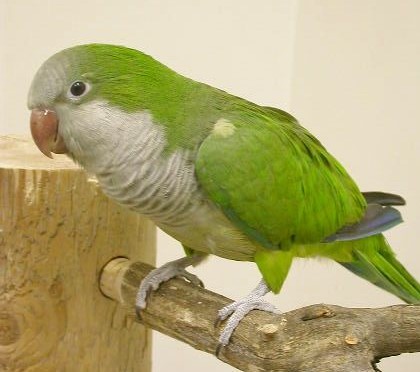
It’s the last day for our July Animal of the Month, which means the Quaker parakeet is flying out of the spotlight in order to make way for our new featured creature. We hope you enjoyed our tweets all month long on Twitter @ExoticPetVets about these social and sassy birds. In case you missed any, the following is a summary of our tweets. Did you know?:
- The Quaker parakeet (Myiopsitta monachus) is native to South America; specifically, to Argentina and surrounding countries.
- There are also feral populations of Quaker parakeets around the world, including in British Columbia, several U.S. States, parts of Europe, the Caribbean and Asia.
- The feral populations of Quaker parakeets are all believed to have originated from birds who escaped from captivity.
- Even though Quaker parakeets are native to subtropical climates in South America, they are hardy birds and their feral populations have been able to adapt to life in colder environments.
- Quaker parakeets are small parrots, with adults measuring 12 inches (30 cms) in length.
- Quaker parakeets have distinctive grey feathers on their forehead, cheeks, throat and chest. The rest of their original colours are bright green on the head, back and wings, lighter green on the underside of their tails and blue flight feathers.
- Selective breeding of captive Quaker parakeets has resulted in different colour mutations, including blue, lutino and albino.
- Female and male Quaker parakeets look the same, meaning they are monomorphic. DNA testing is the best way to find out if a Quaker is female or male.
- The Quaker parakeet is known by many other common names; most notably the monk parakeet or parrot. They are also known as the grey-headed parakeet and the grey-breasted parakeet.
- What is behind the names Quaker parakeet and monk parakeet? They are known by these names due to the grey feathers on their chests, necks and faces. This pattern can remind people of garments that are worn by Quakers or monks.
- But it has also been suggested that Quaker parakeets are so named because of their unique behaviour of shaking and quaking, which they do when they are excited.
- Quaker parakeets are unique among all parrot species in that they are the only parrots who don’t nest in tree cavities and they are the only parrots who nest communally.
- Quaker parakeets will build nests out of twigs and branches. The nests can be quite large and elaborate with multiple rooms and each mating pair getting their own space. The nest structure is like little apartment building.
- In the wild, Quaker parakeets will ideally build their nests in trees. But in urban areas they will build their nests on utility poles, which have caused blackouts and fires.
- Quaker parakeets have strong nesting instincts and are known for being territorial about their cages when kept in captivity, especially during breeding season.
- Quaker parakeets in captivity will also try to build nests and will regularly steal items from around the house in order to build their nest.
- Quaker parakeets are very intelligent birds and are great at mimicking human speech and sounds. They can develop a vocabulary of up to 50 or 60 words.
- As a result of being very social birds, dozens of Quaker parakeets will live together in their large communal nest structures.
- Quaker parakeets will form socially monogamous pairs. Their courting behaviour includes preening each other, and grasping each other’s beaks and shaking their heads.
- Quaker parakeets have a long lifespan in captivity. In the wild, they will live about six years on average. But if well cared for, they can live between 20 and 30 years in captivity.

